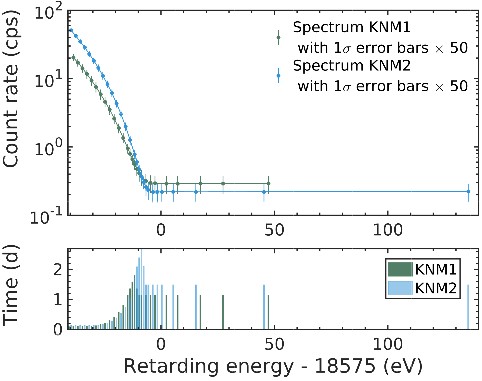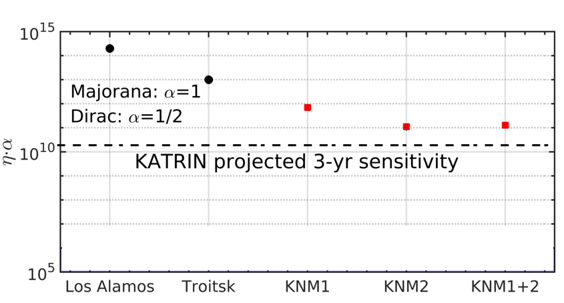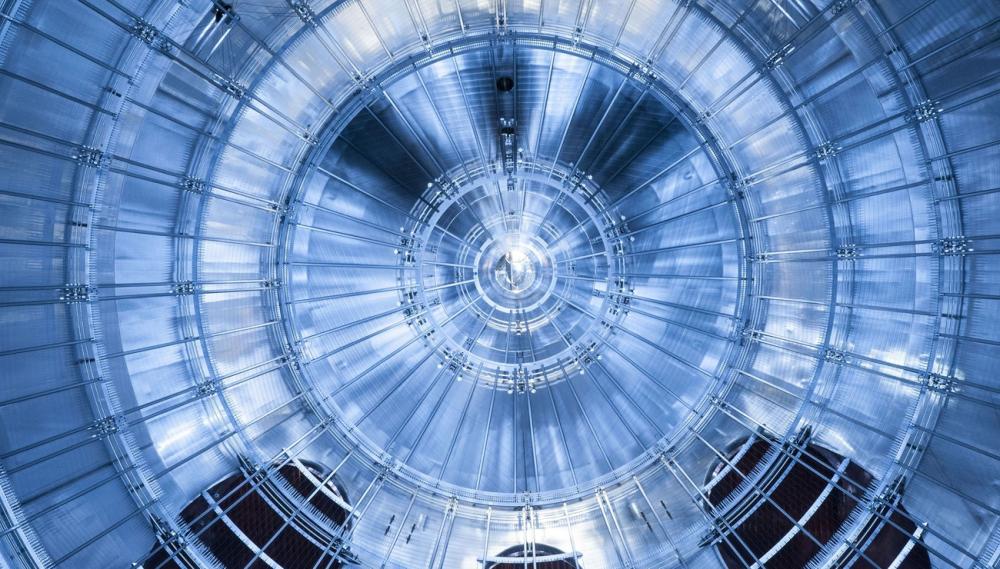The cosmic background neutrino is one of the predictions of the standard cosmological model, but it has never been directly observed. These so-called "relic neutrinos" could be captured on a radioactive nucleus like tritium. The resulting capture rate depends on the local density of relic neutrinos. Since massive neutrinos get caught by the gravitational potential of our galaxy and cluster locally, a modest local overdensity of relic neutrinos should exist on Earth. More exotic considerations could lead to more substantial overdensities. The KATRIN experiment published in June 2022 in Physical Review Letters its first search for relic neutrinos based on analysis of data recorded in 2019. The analysis, led by an IRFU physicist, improves on previous limits by two orders of magnitude.
Relic neutrinos
The standard cosmological model predicts a high abundance of relic neutrinos produced in the early stages of the evolution of the Universe, about one second after the Big-Bang. These neutrinos, which are to date the most abundant known particles of matter in the Universe, have been streaming freely for over 13 billion years. Today they have an energy of about one thousandth of an electron volt and an average density of 336 per cubic centimeter. We have only indirect evidence of their existence, from the fact that the ultra-relativistic character of neutrinos during their decoupling from the rest of the Universe influences the energy density of radiation in the primordial Universe. The presence of these ultra-relativistic particles is experimentally attested by the precise observation of the anisotropies of the cosmic microwave background by the Planck satellite. This is an indirect, though very strong, confirmation of the existence of ultra-relativistic particles in the early universe. Nevertheless, only a direct detection of relic neutrinos would assure us that these particles are indeed the neutrinos of the standard model. This observation would also allow us to push back the temporal limit of the Big-Bang observation to a few seconds (see figure 1), with perhaps some surprises in store.
The KATRIN experiment
The international KATRIN experiment, which brings together 20 laboratories from 7 countries and is located at the Karlsruhe Institute of Technology (KIT) in Germany, is designed to measure the mass of neutrinos with unprecedented precision (see Highlights). The Karlsruhe Institute of Technology houses the Karlsruhe Tritium Laboratory (TLK), a state-of-the-art tritium processing and supply facility for the KATRIN experiment. Its current inventory is about 25 grams of tritium, but only 200 micrograms are present in the source of the KATRIN device at any given time, and only a few percent of the captures are a-priori observable.
Principle of the search for relic neutrinos in KATRIN
On the detection side, a process that does not require an energy threshold must be considered because of the tiny kinetic energy of relic neutrinos that have traveled more than 13 billion years in our expanding Universe. One of the most promising methods is thus the capture of neutrinos on nuclei by a reverse beta process illustrated in Figure 2 (left): a relic neutrino, at the fixed energy of the diffuse neutrino background, can be captured by a tritium nucleus and produce an electron by the following reaction: neutrino + tritium → electron + helium. Since tritium and He atoms can be considered to be at rest, KATRIN therefore looks for monoenergetic electrons with energies just above the endpoint of the β decay spectrum, at about 18,575 eV. To distinguish the signal from background events, an energy resolution of the same order as the neutrino mass is required. A priori, about 100 grams of tritium are required for the detection of a density of 336 neutrinos per cubic centimeter, therefore KATRIN, with about 10 µg usable for this search, can only set an upper limit on the overdensity of relic neutrinos around the Earth, noted η.

Figure 2: On the left, neutrino capture on a tritium nucleus associated with the emission of an electron, the latter being sought in the KATRIN experiment. On the right, schematic of the searched signal, a neutrino capture peak (red) beyond the maximum energy of the beta decay electrons (in black, depending on the mass of the neutrino). The KATRIN collaboration (KIT).
New results from KATRIN
In a paper published in Physical Review Letters [Phys. Rev. Lett. 129, 011806] the KATRIN collaboration presents its first search for relic neutrinos from two measurement campaigns conducted in 2019. During the first one (named KNM1) the source was operated in a "run-in" configuration at a reduced activity corresponding to 3.4 μg of usable tritium for the relic neutrino search for 522 hours. During the second campaign (KNM2) the tritium source was operated at its nominal activity with 13.0 μg of usable tritium for 744 hours and the background noise was reduced by one quarter, to 0.22 counts per second. A direct comparison of the experimental parameters is given in Figure 4.

Figure 4: Top: Electronic spectra of the two data sets (KNM1 and KNM2) shifted from the maximum energy of the beta spectrum of 18575 eV. Error bars are multiplied by 50 to be readable. The blue and green lines represent data from KNM1 and KNM2, respectively. Below 18575 eV, the KNM2 spectrum shows a higher count rate due to the increase in tritium activity from KNM1 to KNM2. Above 18575 eV, we note a 25% reduced background between KNM1 and KNM2. Bottom: measurement time distributions of the two data sets. The KATRIN collaboration.
No signal is detected, but the relic neutrino overdensity is limited to less than one hundred billion. Although still far from the sensitivity required for a detection, this new result from KATRIN improves by two orders of magnitude sensitivity of previous searches, as shown in Figure 5. The measurement uncertainty is dominated by the statistical error and these results will be further refined in the coming years.

Figure 5: Overview of the new KATRIN limits on the relic neutrino overdensity around the Earth (95% confidence level). The capture rate of relic neutrinos on a tritium nucleus varies between Dirac and Majorana neutrinos (parameterized with the alpha variable on the y-axis). The new result of KATRIN (in red) is compared to the constraints of the previous experiments at Los Alamos and Troitsk (in black). The increase in sensitivity is two orders of magnitude. @ The KATRIN collaboration (KIT).
Conclusion
The objective of direct detection of the relic neutrino background is very ambitious and the capture of neutrinos on radioactive tritium nuclei is one of the most promising ways. However, an energy resolution of 50 meV (today 2 eV) and a quantity of tritium of 100 grams (today 0.00001 gram!) will be needed to be able to observe relic neutrinos. This first result of KATRIN is still very far from a proven detection. However, KATRIN has the best data available on the planet for this research. This new result opens the way to future fascinating studies and increases the prospect of observing cosmic relic neutrinos in a future that we hope is not so far away...
The role of the IRFU
At the IRFU particle physics department, Thierry Lasserre has coordinated this analysis in collaboration with the TUM University (Munich) and has coordinated the publication for the KATRIN collaboration.
Contact: Thierry Lasserre
References:
https://journals.aps.org/prl/abstract/10.1103/PhysRevLett.129.011806
https://physics.aps.org/articles/v15/s85
• The ultimate constituents of matter › Neutrino Physics
• The Particle Physics Division





